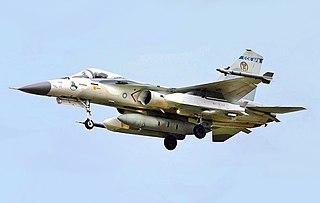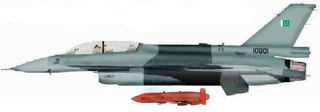
The AGM-154 Joint Standoff Weapon (JSOW) is a glide bomb that resulted from a joint venture between the United States Navy and Air Force to deploy a standardized medium range precision guided weapon, especially for engagement of defended targets from outside the range of standard anti-aircraft defenses, thereby increasing aircraft survivability and minimizing friendly losses. It is intended to be used against soft targets such as parked aircraft, trucks, armored personnel carriers (APCs), and surface-to-air missile sites (SAMs). Prior to launch, it is given a destination through either a predesignated waypoint or a point marked through a targeting pod. It glides, using two wings that pop out for added lift, to the marked destination and dispenses submunitions in a short, roughly linear pattern. The designation of the Joint Standoff Weapon as an "air-to-ground missile" is a misnomer, as it is an unpowered bomb with guidance avionics, similar to the older GBU-15.

The AGM-86 ALCM is an American subsonic air-launched cruise missile (ALCM) built by Boeing and operated by the United States Air Force. This missile was developed to increase the effectiveness and survivability of the Boeing B-52H Stratofortress strategic bomber. The missile dilutes an enemy's forces and complicates air defense of its territory.

An air-to-surface missile (ASM) or air-to-ground missile (AGM) is a missile designed to be launched from military aircraft at targets on land or sea. There are also unpowered guided glide bombs not considered missiles. The two most common propulsion systems for air-to-surface missiles are rocket motors, usually with shorter range, and slower, longer-range jet engines. Some Soviet-designed air-to-surface missiles are powered by ramjets, giving them both long range and high speed.

The Williams F107 is a small turbofan engine made by Williams International. The F107 was designed to propel cruise missiles. It has been used as the powerplant for the AGM-86 ALCM, and BGM-109 Tomahawk, as well as the experimental Kaman KSA-100 SAVER and Williams X-Jet flying platform.

The AGM-129 ACM was a low-observable, subsonic, turbofan-powered, air-launched cruise missile originally designed and built by General Dynamics and eventually acquired by Raytheon Missile Systems. Prior to its withdrawal from service in 2012, the AGM-129A was carried exclusively by the US Air Force's B-52H Stratofortress bombers.

The AGM-83 Bulldog was a missile produced by the United States.

The AGM-78 Standard ARM was an anti-radiation missile developed by General Dynamics, United States. It was built on the airframe of the RIM-66 Standard surface-to-air missile, resulting in a very large weapon with considerable range, allowing it to attack targets as much as 50 miles (80 km) away.
The Northrop AGM-137 TSSAM was a standoff cruise missile developed for the three branches of the United States Armed Forces, hence "tri-service". Missile development began in 1986 but revelation of cost-overruns in 1991 prompted the Army to pull out of the project and an investigation of the procurement process by the General Accounting Office. The TSSAM program was eventually cancelled in December 1994 pursuant to a GAO recommendation and the loss of support of the United States Army after going as far as several test launches.

The AGM-158 JASSM is a low detection standoff air-launched cruise missile developed by Lockheed Martin for the United States Armed Forces. It is a large, stealthy long-range weapon with a 1,000-pound (450 kg) armor piercing warhead. It completed testing and entered service with the U.S. Air Force in 2009, and has entered foreign service in Australia, Finland, and Poland as of 2014. An extended range version of the missile, the AGM-158B JASSM-ER, entered service in 2014 as well as an anti-ship derivative, the AGM-158C LRASM, in 2018. By September 2016, Lockheed Martin had delivered 2,000 total JASSMs comprising both variants to the USAF.
Standoff weapons are missiles or bombs which may be launched from a distance sufficient to allow attacking personnel to evade the effect of the weapon or defensive fire from the target area. Typically, they are used against land- and sea-based targets in an offensive operation. The name is derived from their ability to engage the target while standing off outside the range at which the defenders are likely to engage the attacker. Typical stand-off weapons include cruise missiles, glide bombs and short-range ballistic missiles.
Lockheed Martin Missiles and Fire Control (MFC) is one of the four core business areas for American company Lockheed Martin.

The Wan Chien is an air to ground cruise missile developed and produced by the National Chung-Shan Institute of Science and Technology (NCSIST) of Taiwan.

The Teledyne CAE J402 is a small turbojet engine. Several variants have been developed to power unmanned air vehicles such as missiles and target drones. Developed in the 1970s for the Harpoon anti-ship missile, the J402 was the first jet engine to be designed as a "wooden round", meaning that the engine had to be able to sit for long periods without maintenance or inspection and work right away.

The AGM-158C LRASM is a stealth air launch anti-ship cruise missile developed for the United States Air Force and United States Navy by the Defense Advanced Research Projects Agency (DARPA). Derived from the AGM-158B JASSM-ER, the LRASM was intended to pioneer more sophisticated autonomous targeting capabilities than the U.S. Navy's current Harpoon anti-ship missile, which has been in service since 1977.

The Ra'ad, is a subsonic, standoff, and an air-launched cruise missile (ALCM) designed and jointly developed by the National Engineering & Scientific Commission (NESCOM) and Pakistan Air Force's Air Weapons Complex.

An air-launched cruise missile (ALCM) is a cruise missile that is launched from a military aircraft. Current versions are typically standoff weapons which are used to attack predetermined land targets with conventional, nuclear or thermonuclear payloads.
The Ra'ad-II is a standoff and an air-launched cruise missile (ALCM) derived from the Hatf-VIII Ra'ad. It was first publicly unveiled on the Pakistan Day Parade on 23 March 2017,
The AGM-181 Long Range Stand Off Weapon (LRSO) is a nuclear-armed air-launched cruise missile under development by Raytheon Technologies that will replace the AGM-86 ALCM.

Rapid Dragon is a palletized and disposable weapons module which is airdropped in order to deploy flying munitions, typically cruise missiles, from unmodified cargo planes. Developed by the United States Air Force and Lockheed, the airdrop-rigged pallets, called "deployment boxes," provide a low cost method allowing unmodified cargo planes, such as C-130 or C-17 aircraft, to be temporarily repurposed as standoff bombers capable of mass launching any variant of long or short range AGM-158 JASSM cruise missiles against land or naval targets.